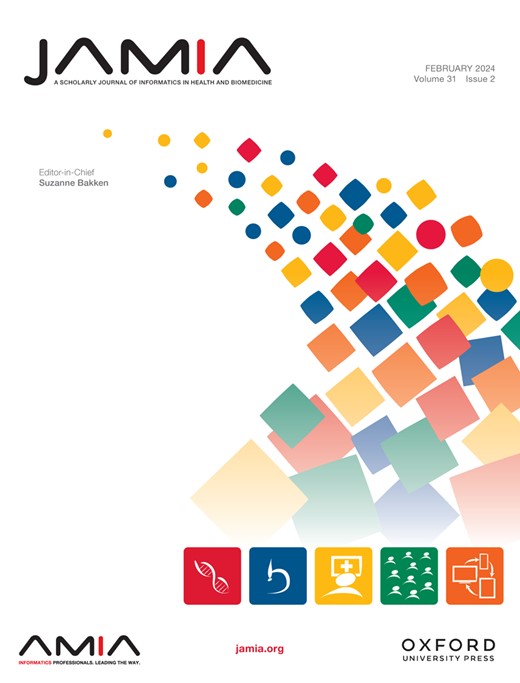电子健康记录系统的使用与急危重症护理临床护士的记录负担:一项混合方法研究
IF 4.7
2区 医学
Q1 COMPUTER SCIENCE, INFORMATION SYSTEMS
Journal of the American Medical Informatics Association
Pub Date : 2024-09-12
DOI:10.1093/jamia/ocae239
引用次数: 0
摘要
目的 研究急诊和重症监护护士使用电子健康记录(EHR)的情况以及造成记录负担的因素。材料和方法 在技术接受和使用统一理论指导下,采用混合方法设计。关键的电子病历组件包括流程表、用药管理记录(MAR)、护理计划、笔记和导航器。我们首先通过对电子病历日志文件的分析,确定了 1 所大学医院中文档负担最重的 5 个科室。我们为每个科室招募了四名护士,并对他们进行了访谈和调查,以了解他们对 5 个电子病历组件的易用性和实用性的看法。定性数据分析采用了归纳/演绎编码相结合的方法。结果 护士们承认文件记录对病人护理的重要性,但认为所需的文件记录是一种负担,5 个组件的负担程度各不相同。造成负担的因素包括非电子病历问题(病人与护士的人员配备比;病人的严重程度;时间管理不理想)和与设计/功能有关的电子病历可用性问题。与 MAR 和 Notes 相比,Flowheets、Care Plan 和 Navigators 的可用性低于可接受水平,造成了更多负担。最令人头疼的电子病历可用性问题是数据冗余、工作流程导航不畅以及根据单位类型输入数据繁琐。讨论 总的来说,我们利用定量和定性数据强调了当前电子病历中护理文件功能所面临的挑战,这些挑战造成了文件记录的负担。EHR 文档组件在可用性方面的感知差异是由多种因素造成的,例如与工作流程不匹配以及重复之前数据录入的数量。护士们提出了一些改进电子病历的建议,包括尽量减少冗余或过多的数据录入要求、提供视觉提示(如清晰的错误信息、突出显示缺失或错误信息的区域)以及整合决策支持。结论 我们的研究为护士使用电子病历和造成负担的特定文档可用性问题提供了证据。研究结果可为制定解决方案提供参考,以提高多组件电子病历的可用性,适应护士独特的工作流程。旨在改善护士工作条件的文档策略应包括非电子病历因素,因为它们也会造成文档负担。本文章由计算机程序翻译,如有差异,请以英文原文为准。
Electronic health record system use and documentation burden of acute and critical care nurse clinicians: a mixed-methods study
Objectives Examine electronic health record (EHR) use and factors contributing to documentation burden in acute and critical care nurses. Materials and Methods A mixed-methods design was used guided by Unified Theory of Acceptance and Use of Technology. Key EHR components included, Flowsheets, Medication Administration Records (MAR), Care Plan, Notes, and Navigators. We first identified 5 units with the highest documentation burden in 1 university hospital through EHR log file analyses. Four nurses per unit were recruited and engaged in interviews and surveys designed to examine their perceptions of ease of use and usefulness of the 5 EHR components. A combination of inductive/deductive coding was used for qualitative data analysis. Results Nurses acknowledged the importance of documentation for patient care, yet perceived the required documentation as burdensome with levels varying across the 5 components. Factors contributing to burden included non-EHR issues (patient-to-nurse staffing ratios; patient acuity; suboptimal time management) and EHR usability issues related to design/features. Flowsheets, Care Plan, and Navigators were found to be below acceptable usability and contributed to more burden compared to MAR and Notes. The most troublesome EHR usability issues were data redundancy, poor workflow navigation, and cumbersome data entry based on unit type. Discussion Overall, we used quantitative and qualitative data to highlight challenges with current nursing documentation features in the EHR that contribute to documentation burden. Differences in perceived usability across the EHR documentation components were driven by multiple factors, such as non-alignment with workflows and amount of duplication of prior data entries. Nurses offered several recommendations for improving the EHR, including minimizing redundant or excessive data entry requirements, providing visual cues (eg, clear error messages, highlighting areas where missing or incorrect information are), and integrating decision support. Conclusion Our study generated evidence for nurse EHR use and specific documentation usability issues contributing to burden. Findings can inform the development of solutions for enhancing multi-component EHR usability that accommodates the unique workflow of nurses. Documentation strategies designed to improve nurse working conditions should include non-EHR factors as they also contribute to documentation burden.
求助全文
通过发布文献求助,成功后即可免费获取论文全文。
去求助
来源期刊
CiteScore
14.50
自引率
7.80%
发文量
230
审稿时长
3-8 weeks
期刊介绍:
JAMIA is AMIA''s premier peer-reviewed journal for biomedical and health informatics. Covering the full spectrum of activities in the field, JAMIA includes informatics articles in the areas of clinical care, clinical research, translational science, implementation science, imaging, education, consumer health, public health, and policy. JAMIA''s articles describe innovative informatics research and systems that help to advance biomedical science and to promote health. Case reports, perspectives and reviews also help readers stay connected with the most important informatics developments in implementation, policy and education.

 求助内容:
求助内容: 应助结果提醒方式:
应助结果提醒方式:


